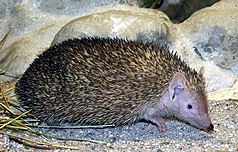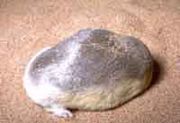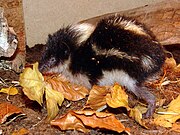List of afrosoricids
Afrosoricida is an order of placental mammals. Members of this order are called afrosoricids, and include golden moles, otter shrews, and tenrecs. They are found in Africa, generally in forests, but also inland wetlands, shrublands, and grasslands. They range in size from the least shrew tenrec, at 4 cm (2 in) plus a 6 cm (2 in) tail, to the giant otter shrew, at 34 cm (13 in) plus a 39 cm (15 in) tail. Afrosoricids primarily eat invertebrates, particularly insects and earthworms, though some will also eat small lizards or other vertebrates. The golden moles have vestigial eyes covered with skin, and track their prey through vibrations rather than sight.[1] No population estimates have been made for any afrosoricid species, though the De Winton's golden mole is classified as Critically Endangered and the giant golden mole, Gunning's golden mole, Jenkins's shrew tenrec, Juliana's golden mole, Marley's golden mole, northern shrew tenrec, and Van Zyl's golden mole are categorized as endangered species.
The fifty-five extant species of Afrosoricida are divided into two suborders, with Chrysochloridea containing the family Chrysochloridae, or golden moles, and Tenrecomorpha containing the families Potamogalidae, or otter shrews, and Tenrecidae, or tenrecs. Chrysochloridae is split into the subfamilies Chrysochlorinae, containing eleven species in six genera, and Amblysominae, containing ten species in four genera. Potamogalidae consists of three species in two genera, while Tenrecidae contains the subfamilies of Geogalinae, comprising a single species, Oryzorictinae, containing twenty-five species in three genera, and Tenrecinae, containing five species in four genera. The order as a whole was traditionally grouped with the hedgehogs, shrews, and moles as part of the order Lipotyphla, but modern molecular phylogenetic analysis resulted in that order being split into Afrosoricida and Eulipotyphla. Few extinct Afrosoricida species have been discovered, though due to ongoing research and discoveries the exact number and categorization are not fixed.[2]
Conventions
[edit]| Conservation status | |
|---|---|
| EX | Extinct (0 species) |
| EW | Extinct in the wild (0 species) |
| CR | Critically Endangered (1 species) |
| EN | Endangered (7 species) |
| VU | Vulnerable (9 species) |
| NT | Near threatened (2 species) |
| LC | Least concern (32 species) |
| Other categories | |
| DD | Data deficient (4 species) |
| NE | Not evaluated (0 species) |
Conservation status codes listed follow the International Union for Conservation of Nature (IUCN) Red List of Threatened Species. Range maps are provided wherever possible; if a range map is not available, a description of the afrosoricid's range is provided. Ranges are based on the IUCN Red List for that species unless otherwise noted. All extinct species or subspecies listed alongside extant species went extinct after 1500 CE, and are indicated by a dagger symbol "†".
Classification
[edit]The order Afrosoricida consists of two suborders, Chrysochloridea and Tenrecomorpha. Chrysochloridea consists of the family Chrysochloridae, or golden moles, and Tenrecomorpha contains the families Potamogalidae, or otter shrews, and Tenrecidae, or tenrecs. Chrysochloridae contains twenty-one species in ten genera, divided into two subfamilies. Potamogalidae consists of three species in two genera, while Tenrecidae contains thirty-one species in eight genera, divided into three subfamilies. Many of these species are further subdivided into subspecies. This does not include hybrid species or extinct prehistoric species.
Suborder Chrysochloridea
- Family Chrysochloridae
- Subfamily Chrysochlorinae
- Genus Carpitalpa (Arends' golden mole): one species
- Genus Chlorotalpa (golden moles): two species
- Genus Chrysochloris (golden moles): three species
- Genus Chrysospalax (golden moles): two species
- Genus Cryptochloris (golden moles): two species
- Genus Eremitalpa (Grant's golden mole): one species
- Subfamily Amblysominae
- Genus Amblysomus (narrow-headed golden moles): five species
- Genus Calcochloris (yellow golden mole): one species
- Genus Huetia (Central African golden moles): two species
- Genus Neamblysomus (golden moles): two species
- Subfamily Chrysochlorinae
Suborder Tenrecomorpha
- Family Potamogalidae
- Genus Micropotamogale (dwarf otter shrews): two species
- Genus Potamogale (giant otter shrew): one species
- Family Tenrecidae
- Subfamily Geogalinae
- Genus Geogale (large-eared tenrec): one species
- Subfamily Oryzorictinae
- Genus Microgale (shrew tenrecs): twenty-one species
- Genus Nesogale (shrew tenrecs): two species
- Genus Oryzorictes (rice tenrecs): two species
- Subfamily Tenrecinae
- Genus Echinops (lesser hedgehog tenrec): one species
- Genus Hemicentetes (streaked tenrecs): two species
- Genus Setifer (greater hedgehog tenrec): one species
- Genus Tenrec (tailless tenrec): one species
- Subfamily Geogalinae
Afrosoricids
[edit]The following classification is based on the taxonomy described by the reference work Mammal Species of the World (2005), with augmentation by generally accepted proposals made since using molecular phylogenetic analysis, as supported by both the IUCN and the American Society of Mammalogists.[6]
Suborder Chrysochloridea
[edit]Family Chrysochloridae
[edit]Subfamily Chrysochlorinae
[edit]| Common name | Scientific name and subspecies | Range | Size and ecology | IUCN status and estimated population |
|---|---|---|---|---|
| Arends's golden mole
|
C. arendsi (Lundholm, 1955) |
Mozambique and Zimbabwe
|
Size: 11–14 cm (4–6 in) long[7] Habitat: Forest and grassland[8] Diet: Insects and earthworms[7] |
VU
|
| Common name | Scientific name and subspecies | Range | Size and ecology | IUCN status and estimated population |
|---|---|---|---|---|
| Duthie's golden mole
|
C. duthieae (Broom, 1907) |
Southern South Africa
|
Size: 9–13 cm (4–5 in) long[9] Habitat: Forest, savanna, and grassland[10] Diet: Earthworms[9] |
VU
|
| Sclater's golden mole
|
C. sclateri (Broom, 1907) Four subspecies
|
South Africa and Lesotho
|
Size: 8–14 cm (3–6 in) long[11] Habitat: Shrubland and grassland[12] Diet: Eathworms and insect larvae[11] |
LC
|
| Common name | Scientific name and subspecies | Range | Size and ecology | IUCN status and estimated population |
|---|---|---|---|---|
| Cape golden mole | C. asiatica (Linnaeus, 1758) |
Western South Africa
|
Size: 9–12 cm (4–5 in) long[13] Habitat: Forest, shrubland, and grassland[14] Diet: Insects and small invertebrates, as well as small lizards[15] |
LC
|
| Stuhlmann's golden mole
|
C. stuhlmanni Matschie, 1894 Three subspecies
|
Scattered central Africa
|
Size: 10–13 cm (4–5 in) long[16] Habitat: Forest, shrubland, and grassland[17] Diet: Earthworms and insect larvae, as well as other invertebrates[16] |
LC
|
| Visagie's golden mole
|
C. visagiei Broom, 1950 |
Western South Africa
|
Size: About 10 cm (4 in) long[18] Habitat: Shrubland[19] Diet: Unknown[18] |
DD
|
| Common name | Scientific name and subspecies | Range | Size and ecology | IUCN status and estimated population |
|---|---|---|---|---|
| Giant golden mole | C. trevelyani (Günther, 1875) |
Southern South Africa
|
Size: 20–24 cm (8–9 in) long[20] Habitat: Forest and grassland[21] Diet: Small invertebrates, especially giant earthworms and millipedes, as well as small vertebrates[21] |
EN
|
| Rough-haired golden mole | C. villosus (Smith, 1833) Six subspecies
|
South Africa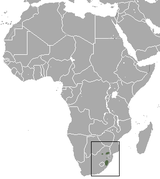
|
Size: 12–18 cm (5–7 in) long[22] Habitat: Shrubland and grassland[23] Diet: Small invertebrates, especially termites and earthworms[22] |
VU
|
| Common name | Scientific name and subspecies | Range | Size and ecology | IUCN status and estimated population |
|---|---|---|---|---|
| De Winton's golden mole
|
C. wintoni (Broom, 1907) |
Western South Africa
|
Size: 8–10 cm (3–4 in) long[24] Habitat: Shrubland[25] Diet: Unknown[24] |
CR
|
| Van Zyl's golden mole
|
C. zyli Shortridge, Carter, 1938 |
Western South Africa
|
Size: About 8 cm (3 in) long[26] Habitat: Shrubland[27] Diet: Unknown[26] |
EN
|
| Common name | Scientific name and subspecies | Range | Size and ecology | IUCN status and estimated population |
|---|---|---|---|---|
| Grant's golden mole | E. granti (Broom, 1907) Two subspecies
|
Western South Africa and Namibia
|
Size: 7–9 cm (3–4 in) long[28] Habitat: Shrubland and desert[29] Diet: Termites and other insects, as well as roots and small lizards[28] |
LC
|
Subfamily Amblysominae
[edit]| Common name | Scientific name and subspecies | Range | Size and ecology | IUCN status and estimated population |
|---|---|---|---|---|
| Fynbos golden mole
|
A. corriae Thomas, 1905 Two subspecies
|
Southern South Africa
|
Size: 10–13 cm (4–5 in) long[30] Habitat: Forest, savanna, shrubland, and grassland[31] Diet: Insects[30] |
NT
|
| Highveld golden mole
|
A. septentrionalis Roberts, 1913 |
Eastern South Africa
|
Size: 10–15 cm (4–6 in) long[32] Habitat: Forest, savanna, shrubland, and grassland[33] Diet: Earthworms and other invertebrates[32] |
NT
|
| Hottentot golden mole | A. hottentotus (Smith, 1829) Five subspecies
|
South Africa
|
Size: 10–14 cm (4–6 in) long[34] Habitat: Forest, savanna, shrubland, and grassland[35] Diet: Earthworms and other invertebrates[34] |
LC
|
| Marley's golden mole
|
A. marleyi Roberts, 1931 |
Eastern South Africa
|
Size: 9–12 cm (4–5 in) long[36] Habitat: Forest, savanna, shrubland, and grassland[37] Diet: Insects[36] |
EN
|
| Robust golden mole
|
A. robustus Bronner, 2000 |
Eastern South Africa
|
Size: 10–15 cm (4–6 in) long[38] Habitat: Shrubland and grassland[39] Diet: Small insects and earthworms[38] |
VU
|
| Common name | Scientific name and subspecies | Range | Size and ecology | IUCN status and estimated population |
|---|---|---|---|---|
| Yellow golden mole | C. obtusirostris (Peters, 1851) Three subspecies
|
Mozambique, South Africa, and Zimbabwe
|
Size: 8–11 cm (3–4 in) long[40] Habitat: Forest and savanna[41] Diet: Insects as well as small lizards[40] |
LC
|
| Common name | Scientific name and subspecies | Range | Size and ecology | IUCN status and estimated population |
|---|---|---|---|---|
| Congo golden mole | H. leucorhinus (Huet, 1885) Two subspecies
|
Western Central Africa
|
Size: 8–10 cm (3–4 in) long[42] Habitat: Forest[43] Diet: Earthworms and other invertebrates[32] |
DD
|
| Somali golden mole
|
H. tytonis (Simonetta, 1968) |
Somalia
|
Size: Unknown[40] Habitat: Savanna[44] Diet: Unknown[40] |
DD
|
| Common name | Scientific name and subspecies | Range | Size and ecology | IUCN status and estimated population |
|---|---|---|---|---|
| Gunning's golden mole
|
N. gunningi (Broom, 1908) |
Northern South Africa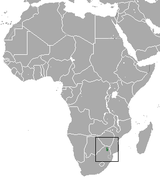
|
Size: 11–14 cm (4–6 in) long[45] Habitat: Forest, shrubland, and grassland[46] Diet: Earthworms[45] |
EN
|
| Juliana's golden mole
|
N. julianae (Meester, 1972) |
Northern South Africa
|
Size: 9–11 cm (4 in) long[47] Habitat: Savanna and grassland[48] Diet: Earthworms and insects[49] |
EN
|
Suborder Tenrecomorpha
[edit]Family Potamogalidae
[edit]| Common name | Scientific name and subspecies | Range | Size and ecology | IUCN status and estimated population |
|---|---|---|---|---|
| Nimba otter shrew
|
M. lamottei Heim de Balsac, 1954 |
Mount Richard-Molard area in western Africa
|
Size: 12–16 cm (5–6 in) long, plus 9–14 cm (4–6 in) tail[50] Habitat: Forest and inland wetlands[51] Diet: Crabs and catfish, as well as insects and tadpoles[51] |
VU
|
| Ruwenzori otter shrew
|
M. ruwenzorii (de Witte, Frechkop, 1955) |
Central Africa
|
Size: 12–20 cm (5–8 in) long, plus 10–15 cm (4–6 in) tail[52] Habitat: Forest and inland wetlands[53] Diet: Insect larvae and worms, as well as small fish, frogs, and crabs[52] |
LC
|
| Common name | Scientific name and subspecies | Range | Size and ecology | IUCN status and estimated population |
|---|---|---|---|---|
| Giant otter shrew | P. velox (Du Chaillu, 1860) |
Central Africa
|
Size: 30–34 cm (12–13 in) long, plus 23–29 cm (9–11 in) tail[54] Habitat: Forest and inland wetlands[55] Diet: Fishes, crabs, shrimps, and water insects, as well as frogs[55] |
LC
|
Family Tenrecidae
[edit]Subfamily Geogalinae
[edit]| Common name | Scientific name and subspecies | Range | Size and ecology | IUCN status and estimated population |
|---|---|---|---|---|
| Large-eared tenrec
|
G. aurita Milne-Edwards, Grandidier, 1872 Two subspecies
|
Scattered Madagascar
|
Size: 6–8 cm (2–3 in) long, plus 3–4 cm (1–2 in) tail[56] Habitat: Forest and shrubland[57] Diet: Ants, termites, and other invertebrates[56] |
LC
|
Subfamily Oryzorictinae
[edit]| Common name | Scientific name and subspecies | Range | Size and ecology | IUCN status and estimated population |
|---|---|---|---|---|
| Cowan's shrew tenrec | M. cowani Thomas, 1882 |
Madagascar
|
Size: 6–10 cm (2–4 in) long, plus 6–8 cm (2–3 in) tail[58] Habitat: Forest[59] Diet: Insects and other invertebrates, as well as small vertebrates[60] |
LC
|
| Drouhard's shrew tenrec | M. drouhardi Grandidier, 1934 |
Eastern Madagascar
|
Size: 6–9 cm (2–4 in) long, plus 5–9 cm (2–4 in) tail[61] Habitat: Forest[62] Diet: Insects and other invertebrates, as well as small vertebrates[60] |
LC
|
| Dryad shrew tenrec
|
M. dryas Jenkins, 1992 |
Northeastern Madagascar
|
Size: 17–18 cm (7–7 in) long, plus tail[63] Habitat: Forest[64] Diet: Invertebrates[63] |
VU
|
| Gracile shrew tenrec
|
M. gracilis (Major, 1896) |
Eastern Madagascar
|
Size: 16–19 cm (6–7 in) long, plus tail[65] Habitat: Forest[66] Diet: Believed to be insects, earthworms, and other invertebrates[65] |
LC
|
| Grandidier's shrew tenrec
|
M. grandidieri Olson, Rakotomalala, Hildebrandt, Lanier, Raxworthy, Goodman, 2009 |
Western Madagascar | Size: 5–8 cm (2–3 in) long, plus 3–4 cm (1–2 in) tail[67] Habitat: Forest and shrubland[68] Diet: Believed to be insects and other invertebrates[67] |
LC
|
| Greater long-tailed shrew tenrec
|
M. principula Thomas, 1926 |
Eastern Madagascar
|
Size: 7–8 cm (3 in) long, plus 14–18 cm (6–7 in) tail[69] Habitat: Forest[70] Diet: Insects and other invertebrates, as well as small vertebrates[60] |
LC
|
| Jenkins's shrew tenrec
|
M. jenkinsae Goodman, Soarimalala, 2004 |
Southwestern Madagascar | Size: 7–8 cm (3 in) long, plus 7–9 cm (3–4 in) tail[71] Habitat: Forest and shrubland[72] Diet: Insects and other invertebrates[60] |
EN
|
| Least shrew tenrec
|
M. pusilla Major, 1896 |
Eastern Madagascar
|
Size: 4–6 cm (2 in) long, plus 6–8 cm (2–3 in) tail[73] Habitat: Forest and inland wetlands[74] Diet: Insects and other invertebrates[60] |
LC
|
| Lesser long-tailed shrew tenrec
|
M. longicaudata Thomas, 1882 |
Central and northern Madagascar
|
Size: 6–8 cm (2–3 in) long, plus 11–16 cm (4–6 in) tail[60] Habitat: Forest[75] Diet: Insects, arachnids, crustaceans, and other invertebrates[76] |
LC
|
| Major's long-tailed tenrec
|
M. majori Thomas, 1918 |
Madagascar
|
Size: 5–7 cm (2–3 in) long, plus 10–14 cm (4–6 in) tail[77] Habitat: Forest[78] Diet: Insects and other invertebrates[60] |
LC
|
| Montane shrew tenrec
|
M. monticola Goodman, Jenkins, 1998 |
Northeastern Madagascar
|
Size: 7–10 cm (3–4 in) long, plus 9–12 cm (4–5 in) tail[79] Habitat: Forest[80] Diet: Insects and other invertebrates[60] |
VU
|
| Naked-nosed shrew tenrec
|
M. gymnorhyncha Jenkins, Goodman, Raxworthy, 1996 |
Eastern Madagascar
|
Size: 13–18 cm (5–7 in) long, plus tail[81] Habitat: Forest[82] Diet: Insects, as well as small mammals, amphibians, vegetation, and potentially carrion[81] |
LC
|
| Nasolo's shrew tenrec
|
M. nasoloi Jenkins, 1999 |
Western Madagascar
|
Size: About 8 cm (3 in) long, plus 5 cm (2 in) tail[83] Habitat: Forest[84] Diet: Insects and other invertebrates[60] |
VU
|
| Northern shrew tenrec
|
M. jobihely Goodman, Raxworthy, Maminirina, Olson, 2006 |
Eastern and northern Madagascar
|
Size: 4–7 cm (2–3 in) long, plus 4–6 cm (2 in) tail[85] Habitat: Forest[86] Diet: Insects and other invertebrates[60] |
EN
|
| Pale shrew tenrec
|
M. fotsifotsy Jenkins, Raxworthy, Nussbaum, 1997 |
Eastern and northern Madagascar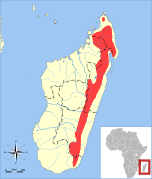
|
Size: 6–9 cm (2–4 in) long, plus 7–10 cm (3–4 in) tail[79] Habitat: Forest[87] Diet: Insects and other invertebrates[60] |
LC
|
| Pygmy shrew tenrec
|
M. parvula Grandidier, 1934 |
Eastern and northern Madagascar
|
Size: 5–7 cm (2–3 in) long, plus 4–7 cm (2–3 in) tail[88] Habitat: Forest[89] Diet: Insects and other invertebrates[60] |
LC
|
| Short-tailed shrew tenrec
|
M. brevicaudata Grandidier, 1899 |
Western and northern Madagascar
|
Size: 6–7 cm (2–3 in) long, plus 3 cm (1 in) tail[90] Habitat: Forest and shrubland[91] Diet: Insects and small vertebrates[90] |
LC
|
| Shrew-toothed shrew tenrec
|
M. soricoides Jenkins, 1993 |
Eastern Madagascar
|
Size: 7–11 cm (3–4 in) long, plus 8–11 cm (3–4 in) tail[92] Habitat: Forest[93] Diet: Insects and other invertebrates, as well as small vertebrates[60] |
LC
|
| Taiva shrew tenrec
|
M. taiva Major, 1896 |
Eastern Madagascar
|
Size: 5–8 cm (2–3 in) long, plus 7–9 cm (3–4 in) tail[85] Habitat: Forest[94] Diet: Insects and other invertebrates[60] |
LC
|
| Thomas's shrew tenrec
|
M. thomasi Major, 1896 |
Eastern Madagascar
|
Size: 7–12 cm (3–5 in) long, plus 5–8 cm (2–3 in) tail[77] Habitat: Forest[95] Diet: Insects and other invertebrates[60] |
LC
|
| Web-footed tenrec
|
M. mergulus Major, 1896 |
Eastern Madagascar
|
Size: 12–17 cm (5–7 in) long, plus 11–17 cm (4–7 in) tail[96] Habitat: Forest and inland wetlands[97] Diet: Insects, as well as tadpoles and crayfish[96] |
VU
|
| Common name | Scientific name and subspecies | Range | Size and ecology | IUCN status and estimated population |
|---|---|---|---|---|
| Dobson's shrew tenrec
|
N. dobsoni (Thomas, 1884) |
Eastern and northern Madagascar
|
Size: 9–12 cm (4–5 in) long, plus 10–11 cm (4 in) tail[98] Habitat: Forest[99] Diet: Insects and ant eggs[98] |
LC
|
| Talazac's shrew tenrec
|
N. talazaci (Major, 1896) |
Eastern Madagascar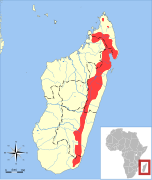
|
Size: 4–13 cm (2–5 in) long, plus 4–16 cm (2–6 in) tail[100] Habitat: Forest[101] Diet: Insects as well as frogs[100] |
LC
|
| Common name | Scientific name and subspecies | Range | Size and ecology | IUCN status and estimated population |
|---|---|---|---|---|
| Four-toed rice tenrec
|
O. tetradactylus Milne-Edwards, Grandidier, 1882 |
Southeastern Madagascar
|
Size: 10–12 cm (4–5 in) long, plus 4–6 cm (2 in) tail[102] Habitat: Forest, shrubland, grassland, and inland wetlands[103] Diet: Worms, insects, and other invertebrates[102] |
DD
|
| Mole-like rice tenrec | O. hova Grandidier, 1870 |
Eastern and northern Madagascar
|
Size: 9–13 cm (4–5 in) long, plus tail[104] Habitat: Forest and inland wetlands[105] Diet: insects and earthworms, as well as plants[104] |
LC
|
Subfamily Tenrecinae
[edit]| Common name | Scientific name and subspecies | Range | Size and ecology | IUCN status and estimated population |
|---|---|---|---|---|
| Lesser hedgehog tenrec | E. telfairi Martin, 1838 |
Southwestern Madagascar
|
Size: 14–18 cm (6–7 in) long, plus 13–17 cm (5–7 in) tail[106] Habitat: Forest, savanna, shrubland, and grassland[107] Diet: Insects and fruit[106] |
LC
|
| Common name | Scientific name and subspecies | Range | Size and ecology | IUCN status and estimated population |
|---|---|---|---|---|
| Highland streaked tenrec | H. nigriceps Günther, 1875 |
Eastern Madagascar
|
Size: 12–16 cm (5–6 in) long[108] Habitat: Forest and savanna[109] Diet: Soft-bodied invertebrates[109] |
LC
|
| Lowland streaked tenrec | H. semispinosus (Cuvier, 1798) |
Eastern Madagascar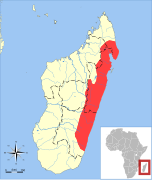
|
Size: 13–19 cm (5–7 in) long[110] Habitat: Forest and shrubland[111] Diet: Worms and other invertebrates[112] |
LC
|
| Common name | Scientific name and subspecies | Range | Size and ecology | IUCN status and estimated population |
|---|---|---|---|---|
| Greater hedgehog tenrec | S. setosus (Schreber, 1778) |
Madagascar
|
Size: 16–23 cm (6–9 in) long, plus tail[113] Habitat: Forest, savanna, shrubland, and grassland[114] Diet: Insects, grubs, other invertebrates, and fruit[113] |
LC
|
| Common name | Scientific name and subspecies | Range | Size and ecology | IUCN status and estimated population |
|---|---|---|---|---|
| Tailless tenrec | T. ecaudatus (Schreber, 1777) |
Madagascar
|
Size: 26–39 cm (10–15 in) long[115] Habitat: Forest, savanna, shrubland, and grassland[116] Diet: Invertebrates, as well as vegetation, fruit, reptiles, amphibians, and small mammals[115] |
LC
|
References
[edit]- ^ Kingdon, Happold, Hoffmann, Butynski, Happold, Kalina, p. 223
- ^ "Fossilworks: Afrosoricida". Paleobiology Database. University of Wisconsin–Madison. Retrieved November 24, 2022.
- ^ Everson, K. M.; Soarimalala, V.; Goodman, S. M.; Olson, L. E. (2016). "Multiple Loci and Complete Taxonomic Sampling Resolve the Phylogeny and Biogeographic History of Tenrecs (Mammalia: Tenrecidae) and Reveal Higher Speciation Rates in Madagascar's Humid Forests". Systematic Biology. 65 (5): 890–909. doi:10.1093/sysbio/syw034. PMID 27103169.
- ^ Upham, Nathan S.; Esselstyn, Jacob A.; Jetz, Walter (2019). "Inferring the mammal tree: Species-level sets of phylogenies for questions in ecology, evolution and conservation". PLOS Biology. 17 (12): e3000494. doi:10.1371/journal.pbio.3000494. PMC 6892540. PMID 31800571.
- ^ Asher, R. J.; Maree, S.; Bronner, G.; Bennett, N. C.; Bloomer, P.; Czechowski, P.; Meyer, M.; Hofreiter, M. (2010). "A phylogenetic estimate for golden moles (Mammalia, Afrotheria, Chrysochloridae)". BMC Evolutionary Biology. 10 (1): 69. Bibcode:2010BMCEE..10...69A. doi:10.1186/1471-2148-10-69. PMC 2850353. PMID 20214773.
- ^ Wilson, Reeder, pp. 71–81
- ^ a b Kingdon, Happold, Hoffmann, Butynski, Happold, Kalina, p. 238
- ^ a b Bronner, G. (2015). "Carpitalpa arendsi". IUCN Red List of Threatened Species. 2015: e.T40596A21289173. doi:10.2305/IUCN.UK.2015-2.RLTS.T40596A21289173.en.
- ^ a b Kingdon, Happold, Hoffmann, Butynski, Happold, Kalina, p. 240
- ^ a b Bronner, G. (2015). "Chlorotalpa duthieae". IUCN Red List of Threatened Species. 2015: e.T4768A21285581. doi:10.2305/IUCN.UK.2015-2.RLTS.T4768A21285581.en.
- ^ a b Kingdon, Happold, Hoffmann, Butynski, Happold, Kalina, p. 241
- ^ a b Bronner, G. (2015). "Chlorotalpa sclateri". IUCN Red List of Threatened Species. 2015: e.T4766A21285759. doi:10.2305/IUCN.UK.2015-2.RLTS.T4766A21285759.en.
- ^ Kingdon, Happold, Hoffmann, Butynski, Happold, Kalina, p. 244
- ^ a b Bronner, G. (2015). "Chrysochloris asiatica". IUCN Red List of Threatened Species. 2015: e.T40600A21288387. doi:10.2305/IUCN.UK.2015-2.RLTS.T40600A21288387.en.
- ^ Valentine, Shaley (2013). "Chrysochloris asiatica". Animal Diversity Web. University of Michigan. Retrieved November 23, 2022.
- ^ a b Kingdon, Happold, Hoffmann, Butynski, Happold, Kalina, p. 245
- ^ a b Bronner, G. (2015). "Chrysochloris stuhlmanni". IUCN Red List of Threatened Species. 2015: e.T40601A21288271. doi:10.2305/IUCN.UK.2015-2.RLTS.T40601A21288271.en.
- ^ a b Kingdon, Happold, Hoffmann, Butynski, Happold, Kalina, p. 246
- ^ a b Bronner, G. (2015). "Chrysochloris visagiei". IUCN Red List of Threatened Species. 2015: e.T4812A21287855. doi:10.2305/IUCN.UK.2015-2.RLTS.T4812A21287855.en.
- ^ Kingdon, Happold, Hoffmann, Butynski, Happold, Kalina, p. 248
- ^ a b c Bronner, G. (2015). "Chrysospalax trevelyani". IUCN Red List of Threatened Species. 2015: e.T4828A21289898. doi:10.2305/IUCN.UK.2015-2.RLTS.T4828A21289898.en.
- ^ a b Carter, Terra (2015). "Chrysospalax villosus". Animal Diversity Web. University of Michigan. Retrieved November 23, 2022.
- ^ a b Bronner, G. (2015). "Chrysospalax villosus". IUCN Red List of Threatened Species. 2015: e.T4829A21290416. doi:10.2305/IUCN.UK.2015-2.RLTS.T4829A21290416.en.
- ^ a b Kingdon, Happold, Hoffmann, Butynski, Happold, Kalina, p. 251
- ^ a b Bronner, G. (2015). "Cryptochloris wintoni". IUCN Red List of Threatened Species. 2015: e.T5748A21287143. doi:10.2305/IUCN.UK.2015-2.RLTS.T5748A21287143.en.
- ^ a b Kingdon, Happold, Hoffmann, Butynski, Happold, Kalina, p. 252
- ^ a b Bronner, G. (2015). "Cryptochloris zyli". IUCN Red List of Threatened Species. 2015: e.T5749A21286235. doi:10.2305/IUCN.UK.2015-2.RLTS.T5749A21286235.en.
- ^ a b Kingdon, Happold, Hoffmann, Butynski, Happold, Kalina, p. 254
- ^ a b Maree, S. (2015). "Eremitalpa granti". IUCN Red List of Threatened Species. 2015: e.T7994A21283661. doi:10.2305/IUCN.UK.2015-2.RLTS.T7994A21283661.en.
- ^ a b Kingdon, Happold, Hoffmann, Butynski, Happold, Kalina, p. 227
- ^ a b Bronner, G.; Mynhardt, S. (2015). "Amblysomus corriae". IUCN Red List of Threatened Species. 2015: e.T62006A21284863. doi:10.2305/IUCN.UK.2015-2.RLTS.T62006A21284863.en.
- ^ a b c Kingdon, Happold, Hoffmann, Butynski, Happold, Kalina, p. 233
- ^ a b Rampartab, C. (2015). "Amblysomus septentrionalis". IUCN Red List of Threatened Species. 2015: e.T62009A21284057. doi:10.2305/IUCN.UK.2015-2.RLTS.T62009A21284057.en.
- ^ a b Kingdon, Happold, Hoffmann, Butynski, Happold, Kalina, p. 229
- ^ a b Bronner, G.; Mynhardt, S. (2015). "Amblysomus hottentotus". IUCN Red List of Threatened Species. 2015: e.T41316A21286316. doi:10.2305/IUCN.UK.2015-2.RLTS.T41316A21286316.en.
- ^ a b Kingdon, Happold, Hoffmann, Butynski, Happold, Kalina, p. 230
- ^ a b Bronner, G.; Mynhardt, S. (2015). "Amblysomus marleyi". IUCN Red List of Threatened Species. 2015: e.T62007A21284544. doi:10.2305/IUCN.UK.2015-2.RLTS.T62007A21284544.en.
- ^ a b Loisel, Andrew (2020). "Amblysomus robustus". Animal Diversity Web. University of Michigan. Retrieved November 23, 2022.
- ^ a b Rampartab, C. (2015). "Amblysomus robustus". IUCN Red List of Threatened Species. 2015: e.T62008A21284697. doi:10.2305/IUCN.UK.2015-2.RLTS.T62008A21284697.en.
- ^ a b c d Kingdon, Happold, Hoffmann, Butynski, Happold, Kalina, p. 236
- ^ a b Maree, S. (2015). "Calcochloris obtusirostris". IUCN Red List of Threatened Species. 2015: e.T3519A21284422. doi:10.2305/IUCN.UK.2015-2.RLTS.T3519A21284422.en.
- ^ Tang, Amanda (2022). "Calcochloris leucorhinus". Animal Diversity Web. University of Michigan. Retrieved November 23, 2022.
- ^ a b Maree, S. (2015). "Huetia leucorhina". IUCN Red List of Threatened Species. 2015: e.T40597A21288887. doi:10.2305/IUCN.UK.2015-2.RLTS.T40597A21288887.en.
- ^ a b Maree, S. (2015). "Calcochloris tytonis". IUCN Red List of Threatened Species. 2015: e.T4767A21285700. doi:10.2305/IUCN.UK.2015-2.RLTS.T4767A21285700.en.
- ^ a b Kingdon, Happold, Hoffmann, Butynski, Happold, Kalina, p. 256
- ^ a b Maree, S. (2015). "Neamblysomus gunningi". IUCN Red List of Threatened Species. 2015: e.T1087A21283546. doi:10.2305/IUCN.UK.2015-2.RLTS.T1087A21283546.en.
- ^ Kingdon, Happold, Hoffmann, Butynski, Happold, Kalina, p. 257
- ^ a b Maree, S. (2015). "Neamblysomus julianae". IUCN Red List of Threatened Species. 2015: e.T1089A21285354. doi:10.2305/IUCN.UK.2015-2.RLTS.T1089A21285354.en.
- ^ Taylor, Elliot (2013). "Neamblysomus julianae". Animal Diversity Web. University of Michigan. Retrieved November 23, 2022.
- ^ Kingdon, Happold, Hoffmann, Butynski, Happold, Kalina, p. 218
- ^ a b c Stephenson, P. J.; Monadjem, A.; Decher, J.; Phalan, B. (2018). "Micropotamogale lamottei". IUCN Red List of Threatened Species. 2018: e.T13393A111940150. doi:10.2305/IUCN.UK.2018-2.RLTS.T13393A111940150.en.
- ^ a b Smith, James (2009). "Micropotamogale ruwenzorii". Animal Diversity Web. University of Michigan. Retrieved November 23, 2022.
- ^ a b Stephenson, P. J. (2016). "Micropotamogale ruwenzorii". IUCN Red List of Threatened Species. 2016: e.T13394A21287768. doi:10.2305/IUCN.UK.2016-1.RLTS.T13394A21287768.en.
- ^ Kingdon, Happold, Hoffmann, Butynski, Happold, Kalina, p. 222
- ^ a b c Stephenson, P. J.; Goodman, S.; Soarimalala, V. (2016). "Potamogale velox". IUCN Red List of Threatened Species. 2016: e.T18095A97203526. doi:10.2305/IUCN.UK.2016-1.RLTS.T18095A97203526.en.
- ^ a b Garbutt, pp. 40–41
- ^ a b Stephenson, P. J.; Soarimalala, V.; Goodman, S. (2016). "Geogale aurita". IUCN Red List of Threatened Species. 2016: e.T9048A97188944. doi:10.2305/IUCN.UK.2016-1.RLTS.T9048A97188944.en.
- ^ Garbutt, p. 50
- ^ a b Stephenson, P. J.; Soarimalala, V.; Goodman, S. (2016). "Microgale cowani". IUCN Red List of Threatened Species. 2016: e.T40586A97190403. doi:10.2305/IUCN.UK.2016-1.RLTS.T40586A97190403.en.
- ^ a b c d e f g h i j k l m n o Garbutt, p. 46
- ^ Garbutt, p. 53
- ^ a b Stephenson, P. J.; Soarimalala, V.; Goodman, S. (2016). "Microgale drouhardi". IUCN Red List of Threatened Species. 2016: e.T62012A97190851. doi:10.2305/IUCN.UK.2016-1.RLTS.T62012A97190851.en.
- ^ a b Gillespie, Heather (2004). "Microgale dryas". Animal Diversity Web. University of Michigan. Retrieved November 23, 2022.
- ^ a b Stephenson, P. J.; Soarimalala, V.; Goodman, S. (2016). "Microgale dryas". IUCN Red List of Threatened Species. 2016: e.T13356A97191108. doi:10.2305/IUCN.UK.2016-1.RLTS.T13356A97191108.en.
- ^ a b Paulson, Kayla (2011). "Microgale gracilis". Animal Diversity Web. University of Michigan. Retrieved November 23, 2022.
- ^ a b Stephenson, P. J.; Soarimalala, V.; Goodman, S. (2016). "Microgale gracilis". IUCN Red List of Threatened Species. 2016: e.T13343A97191617. doi:10.2305/IUCN.UK.2016-1.RLTS.T13343A97191617.en.
- ^ a b Olson, L. E.; Rakotomalala, Z.; Hildebrandt, K. B. P.; Lanier, H. C.; Raxworthy, C. J.; Goodman, S. M. (2009). "Phylogeography of Microgale brevicaudata (Tenrecidae) and Description of a New Species from Western Madagascar". Journal of Mammalogy. 90 (5): 1095–1110. doi:10.1644/08-MAMM-A-305.1.
- ^ a b Stephenson, P. J.; Soarimalala, V.; Goodman, S. (2016). "Microgale grandidieri". IUCN Red List of Threatened Species. 2016: e.T54008309A97190215. doi:10.2305/IUCN.UK.2016-1.RLTS.T54008309A97190215.en.
- ^ Garbutt, p. 47
- ^ a b Stephenson, P. J.; Soarimalala, V.; Goodman, S. (2016). "Microgale principula". IUCN Red List of Threatened Species. 2016: e.T13350A97201454. doi:10.2305/IUCN.UK.2016-1.RLTS.T13350A97201454.en.
- ^ Garbutt, p. 56
- ^ a b Stephenson, P. J.; Soarimalala, V.; Goodman, S. (2016). "Microgale jenkinsae". IUCN Red List of Threatened Species. 2016: e.T62015A97192062. doi:10.2305/IUCN.UK.2016-1.RLTS.T62015A97192062.en.
- ^ Garbutt, p. 52
- ^ a b Stephenson, P. J.; Soarimalala, V.; Goodman, S. (2016). "Microgale pusilla". IUCN Red List of Threatened Species. 2016: e.T41314A97201685. doi:10.2305/IUCN.UK.2016-1.RLTS.T41314A97201685.en.
- ^ a b Stephenson, P. J.; Soarimalala, V.; Goodman, S. (2016). "Microgale longicaudata". IUCN Red List of Threatened Species. 2016: e.T13344A97200213. doi:10.2305/IUCN.UK.2016-1.RLTS.T13344A97200213.en.
- ^ Stevens, Sarah (2004). "Microgale longicaudata". Animal Diversity Web. University of Michigan. Retrieved November 23, 2022.
- ^ a b Mittermeier, Wilson pp. 170–171
- ^ a b Stephenson, P. J.; Soarimalala, V.; Goodman, S. (2016). "Microgale majori". IUCN Red List of Threatened Species. 2016: e.T62016A97200480. doi:10.2305/IUCN.UK.2016-1.RLTS.T62016A97200480.en.
- ^ a b Garbutt, p. 54
- ^ a b Stephenson, P. J.; Soarimalala, V.; Goodman, S. (2016). "Microgale monticola". IUCN Red List of Threatened Species. 2016: e.T29462A97200712. doi:10.2305/IUCN.UK.2016-1.RLTS.T29462A97200712.en.
- ^ a b Trojan, Louis (2022). "Microgale gymnorhyncha". Animal Diversity Web. University of Michigan. Retrieved November 23, 2022.
- ^ a b Stephenson, P. J.; Soarimalala, V.; Goodman, S. (2016). "Microgale gymnorhyncha". IUCN Red List of Threatened Species. 2016: e.T62014A97191808. doi:10.2305/IUCN.UK.2016-1.RLTS.T62014A97191808.en.
- ^ Goodman, S. M.; Soarimalala, V. (2004). "A new species of Microgale (Lipotyphla: Tenrecidae: Oryzorictinae) from the Foret des Mikea of southwestern Madagascar". Proceedings of the Biological Society of Washington. 117 (3): 251–265.
- ^ a b Stephenson, P. J.; Soarimalala, V.; Goodman, S. (2016). "Microgale nasoloi". IUCN Red List of Threatened Species. 2016: e.T62017A97200965. doi:10.2305/IUCN.UK.2016-1.RLTS.T62017A97200965.en.
- ^ a b Goodman, S.; Raxworthy, C.; Maminirina, C. P.; Olson, L. (2006). "A new species of shrew tenrec (Microgale jobihely) from northern Madagascar". Journal of Zoology. 270 (2): 384–398. doi:10.1111/J.1469-7998.2006.00146.X.
- ^ a b Stephenson, P. J.; Soarimalala, V.; Goodman, S. (2016). "Microgale jobihely". IUCN Red List of Threatened Species. 2016: e.T136628A21282528. doi:10.2305/IUCN.UK.2016-1.RLTS.T136628A21282528.en.
- ^ a b Stephenson, P. J.; Soarimalala, V.; Goodman, S. (2016). "Microgale fotsifotsy". IUCN Red List of Threatened Species. 2016: e.T62013A97191387. doi:10.2305/IUCN.UK.2016-1.RLTS.T62013A97191387.en.
- ^ Garbutt, p. 51
- ^ a b Stephenson, P. J.; Soarimalala, V.; Goodman, S. (2016). "Microgale parvula". IUCN Red List of Threatened Species. 2016: e.T13349A97201228. doi:10.2305/IUCN.UK.2016-1.RLTS.T13349A97201228.en.
- ^ a b Mileski, Adam (2004). "Microgale brevicaudata". Animal Diversity Web. University of Michigan. Retrieved November 23, 2022.
- ^ a b Stephenson, P. J.; Soarimalala, V.; Goodman, S. (2016). "Microgale brevicaudata". IUCN Red List of Threatened Species. 2016: e.T54007828A97189964. doi:10.2305/IUCN.UK.2016-1.RLTS.T54007828A97189964.en.
- ^ Garbutt, p. 55
- ^ a b Stephenson, P. J.; Soarimalala, V.; Goodman, S. (2016). "Microgale soricoides". IUCN Red List of Threatened Species. 2016: e.T62018A97201954. doi:10.2305/IUCN.UK.2016-1.RLTS.T62018A97201954.en.
- ^ a b Stephenson, P. J.; Soarimalala, V.; Goodman, S. (2016). "Microgale taiva". IUCN Red List of Threatened Species. 2016: e.T62019A97202201. doi:10.2305/IUCN.UK.2016-1.RLTS.T62019A97202201.en.
- ^ a b Stephenson, P. J.; Soarimalala, V.; Goodman, S. (2016). "Microgale thomasi". IUCN Red List of Threatened Species. 2016: e.T13355A97202776. doi:10.2305/IUCN.UK.2016-1.RLTS.T13355A97202776.en.
- ^ a b LaPointe, Travis (2012). "Limnogale mergulus". Animal Diversity Web. University of Michigan. Retrieved November 23, 2022.
- ^ a b Stephenson, P. J.; Soarimalala, V.; Goodman, S. (2016). "Limnogale mergulus". IUCN Red List of Threatened Species. 2016: e.T11979A97189690. doi:10.2305/IUCN.UK.2016-1.RLTS.T11979A97189690.en.
- ^ a b Jansa, Sharon (2022). "Microgale dobsoni". Animal Diversity Web. University of Michigan. Retrieved November 23, 2022.
- ^ a b Stephenson, P. J.; Soarimalala, V.; Goodman, S. (2016). "Microgale dobsoni". IUCN Red List of Threatened Species. 2016: e.T40587A97190623. doi:10.2305/IUCN.UK.2016-1.RLTS.T40587A97190623.en.
- ^ a b Belknap, Maureen (2004). "Microgale talazaci". Animal Diversity Web. University of Michigan. Retrieved November 23, 2022.
- ^ a b Stephenson, P. J.; Soarimalala, V.; Goodman, S. (2016). "Microgale talazaci". IUCN Red List of Threatened Species. 2016: e.T41315A97202475. doi:10.2305/IUCN.UK.2016-1.RLTS.T41315A97202475.en.
- ^ a b Garbutt, pp. 43–44
- ^ a b Stephenson, P. J.; Soarimalala, V.; Goodman, S. (2016). "Oryzorictes tetradactylus". IUCN Red List of Threatened Species. 2016: e.T40591A97203290. doi:10.2305/IUCN.UK.2016-1.RLTS.T40591A97203290.en.
- ^ a b Fiely, Jonathan (2005). "Oryzorictes hova". Animal Diversity Web. University of Michigan. Retrieved November 23, 2022.
- ^ a b Stephenson, P. J.; Soarimalala, V.; Goodman, S. (2016). "Oryzorictes hova". IUCN Red List of Threatened Species. 2016: e.T40589A97203050. doi:10.2305/IUCN.UK.2016-1.RLTS.T40589A97203050.en.
- ^ a b Garbutt, p. 36
- ^ a b Stephenson, P. J.; Soarimalala, V.; Goodman, S. (2016). "Echinops telfairi". IUCN Red List of Threatened Species. 2016: e.T40592A97188634. doi:10.2305/IUCN.UK.2016-1.RLTS.T40592A97188634.en.
- ^ McTighe, Luke (2011). "Hemicentetes nigriceps". Animal Diversity Web. University of Michigan. Retrieved November 23, 2022.
- ^ a b c Stephenson, P. J.; Soarimalala, V.; Goodman, S. (2016). "Hemicentetes nigriceps". IUCN Red List of Threatened Species. 2016: e.T62011A97189172. doi:10.2305/IUCN.UK.2016-1.RLTS.T62011A97189172.en.
- ^ Garbutt, p. 37
- ^ a b Stephenson, P. J.; Soarimalala, V.; Goodman, S. (2016). "Hemicentetes semispinosus". IUCN Red List of Threatened Species. 2016: e.T40593A97189434. doi:10.2305/IUCN.UK.2016-1.RLTS.T40593A97189434.en.
- ^ Kokx, Katie (2009). "Hemicentetes semispinosus". Animal Diversity Web. University of Michigan. Retrieved November 24, 2022.
- ^ a b Owens, Rachel (2014). "Setifer setosus". Animal Diversity Web. University of Michigan. Retrieved November 23, 2022.
- ^ a b Stephenson, P. J.; Soarimalala, V.; Goodman, S. (2016). "Setifer setosus". IUCN Red List of Threatened Species. 2016: e.T40594A97203842. doi:10.2305/IUCN.UK.2016-1.RLTS.T40594A97203842.en.
- ^ a b Gorog, Antonia (2022). "Tenrec ecaudatus". Animal Diversity Web. University of Michigan. Retrieved November 23, 2022.
- ^ a b Stephenson, P. J.; Soarimalala, V.; Goodman, S. (2016). "Tenrec ecaudatus". IUCN Red List of Threatened Species. 2016: e.T40595A97204107. doi:10.2305/IUCN.UK.2016-1.RLTS.T40595A97204107.en.
Sources
[edit]- Garbutt, Nick (2007). Mammals of Madagascar. Yale University Press. ISBN 978-0-300-12550-4.
- Bronner, Gary N. (2013). Kingdon, Jonathan; Happold, David; Hoffmann, Michael; Butynski, Thomas; Happold, Meredith; Kalina, Jan (eds.). The Mammals of Africa. Vol. I: Introductory Chapters and Afrotheria. Bloomsbury Publishing. ISBN 978-1-4081-8996-2.
- Mittermeier, Russell A.; Wilson, Don E. (2018). Handbook of the Mammals of the World. Vol. 8. Insectivores, Sloths and Colugos. Lynx Edicions. ISBN 978-84-16728-08-4.
- Bronner, Gary N.; Jenkins, Paulina D. (2005). Wilson, Don E.; Reeder, DeeAnn M. (eds.). Mammal Species of the World. Vol. 1 (3rd ed.). Johns Hopkins University Press. ISBN 978-0-8018-8221-0.

